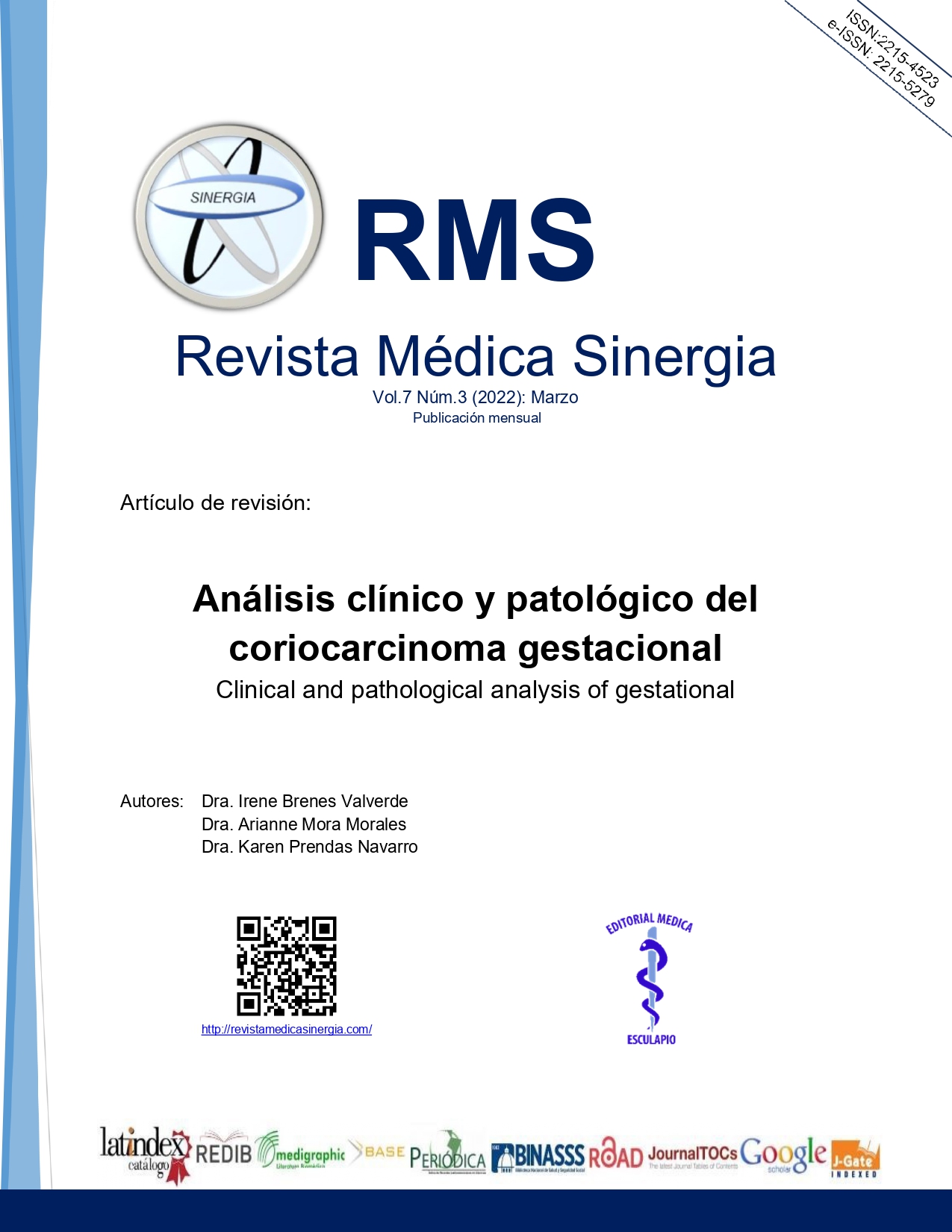Abstract
Choriocarcinoma is a rare but potentially fatal condition if not treated. It is included within the gestational trophoblastic neoplasms (GTN), a group of highly invasive, metastatic and highly vascular malignant tumors. Its presentation after a full-term pregnancy carries a worse prognosis than after an abortion or a hydatidiform mole because it reflects a delay in diagnosis and treatment. Elevated beta Human Chorionic Gonadotropin (β-hCG) levels, Doppler ultrasound, imaging tests, and clinical manifestations are essential to diagnose postpartum choriocarcinoma. Treatment must be early, based on polychemotherapy, although sometimes surgery and radiotherapy are also included.
Keywords
References
Xuan Feng, Zhi Wei, Sai Zhang, Yan Du and Hongbo Zhao. (2019). A Review on the Pathogenesis and Clinical Management of Placental Site Trophoblastic Tumors. Frontiers in Oncology. Vol 9, Article 937. doi: 10.3389/fonc.2019.00937
Andrea Agustín O., Ricardo Savirón C., Diego Lerma P., Ana Herrero I., José Manuel Campillos M. (2015). Casos Clínicos. Coriocarcinoma Postgestacional. Revista Chilena de Obstetricia y Ginecologia. 80(5): 405 - 411
Celia Aparicio-Rubio, Eva Hernández-Lorente, Corina Escoin-Pérez. (2017). Coriocarcinoma: A propósito de un caso. Farmacia Hospitalaria. l Vol. 41 l No 6 l 692 - 693 l
MsC. Vicia Sánchez Abalos, MsC. Carmen Bosch Costafreda y MsC. Tamara Mercedes Sánchez Abalos. (2014). Coriocarcinoma con metástasis pulmonar. MEDISAN. 18(5):705
Patrycja Wreczycka-Cegielny, Tomasz Cegielny, Marcin Oplawski, Wlodzimierz Sawicki, Zbigniew Kojs. (2018). Current treatment options for advanced choriocarcinoma on the basis of own case and review of the literature. The Chair and Clinic of Obstetrics, Gynaecologic Diseases and Oncological Gynaecology of the Second Faculty of Medicine of Warsaw Medical University, Poland. vol. 89, no. 12, 711–715. DOI: 10.5603/GP.a2018.0120
Jiao, L., Ghorani, E., Sebire, N. and Seckl, M., 2016. Intraplacental choriocarcinoma: Systematic review and management guidance. Gynecologic Oncology, 141(3), pp.624-631.
Fen Ning, Houmei Hou, Abraham N. Morse, Gendie E. Lash. (2019). Understanding and management of gestational trophoblastic disease. F1000Research. 8(F1000 Faculty Rev):428 (https://doi.org/10.12688/f1000research.14953.1)
Mishu Mangla, Deepak Singla, Harpreet Kaur, Sushmita Sharma. (2017). Unusual clinical presentations of choriocarcinoma: A systematic review of case reports. Taiwanese Journal of Obstetrics & Gynecology. 56 (1-8).
Kong Y, Yang J, Jiang F, Zhao J, Ren T, Li J, Wang X, Feng F, Wan X, Xiang Y. (2017). Clinical characteristics and prognosis of ultra high-risk gestational trophoblastic neoplasia patients: A retrospective cohort study. PubMed. Gynecol Oncol;146(1):81. Epub 2017 Apr 29.
Ngan HYS, Seckl MJ, Berkowitz RS, Xiang Y, Golfier F, Sekharan PK, Lurain JR, Massuger L. (2018). Update on the diagnosis and management of gestational trophoblastic disease. PubMed. Int J Gynaecol Obstet. 2018;143 Suppl 2:79.
Gestational Trophoblastic Neoplasms (Female Reproductive Organs). In: AJCC Cancer Staging Manual, Eighth Edition, Amin MB (Ed), Springer, Chicago 2017.
A.Cumminga, J.Balanzario-Cuevasa, J.Vitar-Sandovala, J.Monjaras-Guerraa, J.Rodríguez-Roblesa, I.Cortés-Tapiab, G.Regalado-Porrasc, E.Blancasd, V.E.Corona-Montes. (Setiembres 2016). Coriocarcinoma testicular con metástasisa coroides. Revista Mexicana de Urología, vol. 76, páginas 387-391.
Shanbhogue, A. K., Lalwani, N., & Menias, C. O. (2013). Gestational Trophoblastic Disease. Radiologic Clinics, 51(6), 1023-1034.
Dhanda, S., Ramani, S. and Thakur, M., 2014. Gestational Trophoblastic Disease: A Multimodality Imaging Approach with Impact on Diagnosis and Management. Radiology Research and Practice, 2014, pp.1-12.
Wreczycka-Cegielny, P., Cegielny, T., Oplawski, M., Sawicki, W. and Kojs, Z., 2018. Current treatment options for advanced choriocarcinoma on the basis of own case and review of the literature. Ginekologia Polska, 89(12), pp.711-715.
Santaballa A, García Y, Herrero A, Laínez N, Fuentes J, De Juan A, Rodriguez Freixinós V, Aparicio J, Casado A, García-Martinez E. SEOM clinical guidelines in gestational trophoblastic disease (2017). Clinical and Translational Oncology. 2017.
Brown Jubilee, Naumann R. Wendel, Seckl Michael J, Schink Julian. 15 years of progress in gestational trophoblastic disease: Scoring, standardization, and salvage. Gynecologic Oncology, ELSEVIER. 2016. www.elsevier.com/locate/ygyno
Freitas F, Braga A, Viggiano M, et al. Gestational trophoblastic neoplasia lethality among Brazilian women: A retrospective national cohort study. Gynecol Oncol 2020; 158:452.
Balachandran K, Salawu A, Ghorani E, et al. When to stop human chorionic gonadotrophin (hCG) surveillance after treatment with chemotherapy for gestational trophoblastic neoplasia (GTN): A national analysis on over 4,000 patients. Gynecol Oncol 2019; 155:8.
Jean-Jacques Candelier (2016) The hydatidiform mole, Cell Adhesion & Migration, 10:1-2, 226-235, DOI: 10.1080/19336918.2015.1093275
Robbins LS, Cotran SR, Kumar V. Patología Estructural y Funcional. 10ma ed. España: Elsevier 2018.
Ma, N., Litkouhi, B., & Mannion, C. M. (2016). FIGO Stage III Metastatic Gestational Choriocarcinoma Developed From an Antecedent Partial Hydatidiform Molar Pregnancy Bearing a Numerical Chromosomal Aberration 68, XX: A Case Report and Literature Review. International journal of gynecological pathology : official journal of the International Society of Gynecological Pathologists, 35(2), 162–166. https://doi.org/10.1097/PGP.0000000000000215

This work is licensed under a Creative Commons Attribution-NonCommercial 4.0 International License.
Copyright (c) 2022 Array


